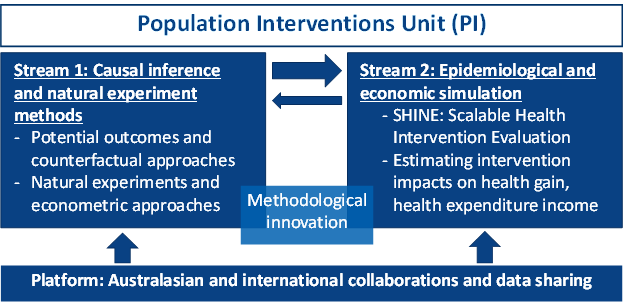Population Interventions
-
Professor

Tony Blakely
Research Overview
The population Interventions Unit (PI) aims are:
- To generate robust evidence on the health and cost impacts of population interventions, through causal inference and sophisticated simulation approaches from epidemiology, economics and data science.
- To impact policy through the provision of high quality, timely and actionable evidence on how interventions change health, health inequalities, future health expenditure and working age economic productivity.

Stream One: Research the effects of interventions on population health
In Stream 1 we use existing data, preferably longitudinal, to estimate causal effects of interventions on health, using contemporary causal inference and natural experiment methods. For example, the impact of Health Star Rating (HSR) nutrition labels on both formulation of food and consumer purchasing.
The PI Unit welcomes collaboration opportunities with researchers interested in applying cutting-edge, contemporary causal inference methods in their work.
Knowledge Sharing
Professor Blakely teaches short courses in contemporary epidemiological methods to equip the next generation of population health researchers and policy-makers with the right tools to answer pressing questions.
Stream Two: Forecasting the health and economic gains of deploying an intervention for a population or a subpopulation over time
Our mission is to be able to quantify the impact of (virtually) any intervention on health, health inequalities, health expenditure and income-earning potential of the population. Stream 2 of PI is about estimating health gains at the population level for an intervention when we already know much about exposure-outcome associations. We seldom systematically ask questions like: “when applied to the population, how much health gain will intervention X achieve compared to intervention Y? Over what time period? At what cost?”

Answering these questions is vital to forecasting the impact of a range of interventions and optimising policy-making for best value-for-money. We call this program of impact-driven research SHINE: Scalable Health Intervention Evaluation. At the SHINE website (currently under development), you will find more information on infrastructure and tools (e.g. interactive league tables, a calculator to estimate health gains and costs for an intervention you have in mind), research collaboration, consulting services, and case studies of SHINE research and impact.
Staff
 Professor Tony Blakely, Unit Head, Epidemiologist & Public Health Medicine Specialist
Professor Tony Blakely, Unit Head, Epidemiologist & Public Health Medicine Specialist
 Dr Driss Ait Ouakrim, Research Fellow in Epidemiology
Dr Driss Ait Ouakrim, Research Fellow in Epidemiology
 Dr Joshua Szanyi, Public Health Registrar
Dr Joshua Szanyi, Public Health Registrar
 Dr Tim Wilson, Simulation Modelling and Software Engineering
Dr Tim Wilson, Simulation Modelling and Software Engineering
 Professor Vijaya Sundararajan, Clinical Epidemiologist
Professor Vijaya Sundararajan, Clinical Epidemiologist
 Hassan Andrabi, Simulation Modelling and Software Engineering
Hassan Andrabi, Simulation Modelling and Software Engineering
Collaborators
PI is built on many Australasian and international collaborations. Key ones include:
- The Burden of Disease Epidemiology, Equity and Cost-Effectiveness Programme (BODE3) at the University of Otago, Wellington, NZ. (Prof Blakely co-directs this programme from 2010-19 and continues as a Co-Director.)
- The Dietary Interventions: Evidence & Translation (DIET) Programme at the University of Auckland, NZ (Prof Blakely co-directs this programme).
- The Institute of health Metrics and Evaluation (home of the Global Burden of Disease Study), the University of Washington – with whom PI is collaborating with building the next-generation simulation model and accessing data.
Funding
PI receives strategic funding by the University of Melbourne, and funding through its projects from:
- The Australian Institute of Health and Welfare (league tables)
- The Health Research Council of New Zealand (health star rating [HSR]).
- National Health and Medical Research Council (NHMRC), as part of the Tobacco Endgame and Healthy Housing Centres of Research Excellence
- Philanthropy
Research Projects
- SHINE - Scalable Health Intervention Evaluation
- Health Star Rating (HSR) label impact on food formulation and consumer purchasing
- Publications
- Contemporary Epidemiology Short Course
- Postgraduate Research Opportunities
Key Contact
For further information about this research, please contact Professor Tony Blakely
Unit / Centre
MDHS Research library
Explore by researcher, school, project or topic.